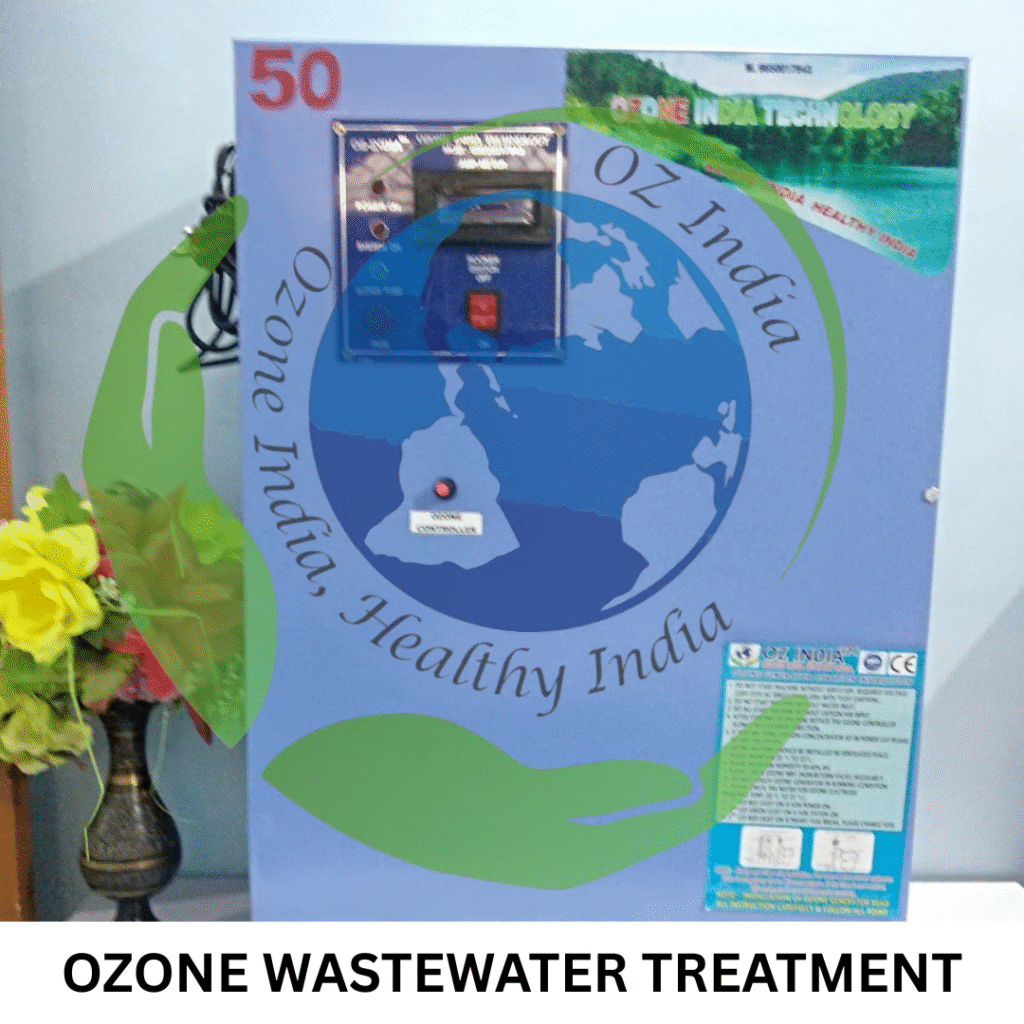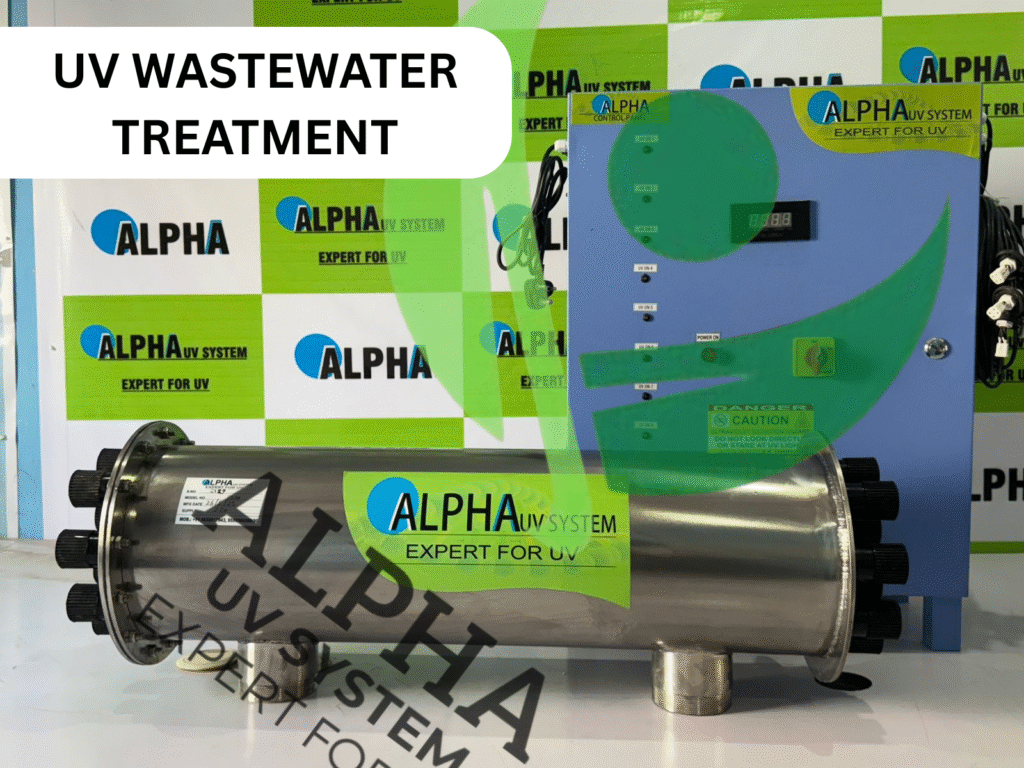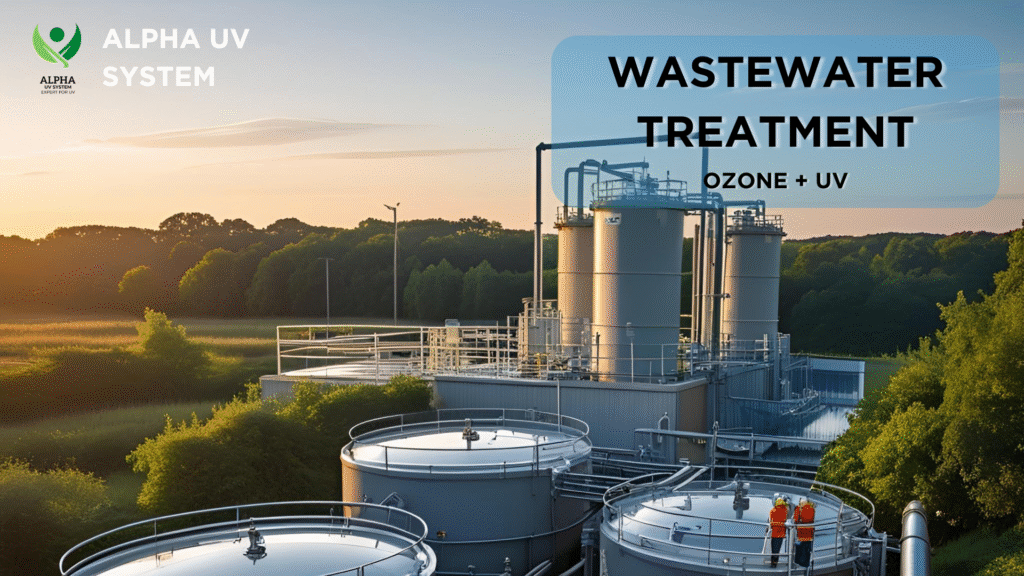As global water scarcity intensifies, the demand for effective and sustainable wastewater treatment technologies has never been higher. Every year, approximately 359 billion cubic meters of wastewater is generated worldwide, with nearly half discharged untreated into natural water bodies. This poses severe risks to environmental health, aquatic ecosystems, and public safety. Traditional wastewater treatment methods, while widely used, increasingly fall short of meeting modern sustainability and safety goals. Against this backdrop, ozone (O₃) and ultraviolet (UV) technologies emerge as revolutionary, chemical-free solutions enabling cleaner, safer, and resource-efficient wastewater treatment.
Why Traditional Disinfection Needs an Upgrade in Wastewater Treatment
The Chlorine Challenge
For decades, chlorine has been the cornerstone of wastewater treatment disinfection due to its strong antimicrobial properties and relative cost-effectiveness. However, chlorine disinfection generates toxic disinfection byproducts (DBPs) such as trihalomethanes (THMs) and haloacetic acids (HAAs) when reacting with organic matter in wastewater. These substances are carcinogenic and pose significant health hazards upon exposure.
Long-term exposure to chlorinated byproducts has been linked to liver and kidney damage, reproductive issues, and even increased cancer risks. Moreover, residual chlorine discharged into water bodies causes toxicity to aquatic life, disrupting biodiversity and ecosystem services.
Limitations of Biological Treatment
Biological processes like activated sludge treatment dominate many wastewater treatment plants due to their efficiency in breaking down organic pollutants. Nonetheless, these systems require substantial land area and generate voluminous biological sludge, which presents further challenges for safe disposal or reuse. Maintaining the microbial communities in biological systems increasingly becomes difficult when incoming wastewater contains toxic chemicals or pharmaceuticals.
Collectively, these challenges emphasize the need for wastewater treatment technologies that are rapid, chemical-free, produce minimal sludge, and avoid harmful residues—gaps that ozone and UV treatment can fill effectively.
Understanding Ozone Wastewater Treatment
What Is Ozone?
Ozone (O₃) is a triatomic oxygen molecule known for its powerful oxidizing capabilities. With an oxidation potential of 2.07 volts, ozone ranks among the strongest disinfectants available, second only to hydroxyl radicals. It naturally decomposes into ordinary oxygen, leaving no harmful residuals behind.
How Ozone Treats Wastewater
In wastewater treatment, ozone oxidizes organic pollutants by breaking molecular bonds and disrupting microbial cell walls. This process leads to the rapid destruction of bacteria, viruses, protozoa, and bio-refractory compounds such as pharmaceuticals and dyes. Simultaneously, ozone treatment reduces odor and color, critical for improving effluent quality.
The oxidative reactions initiated by ozone extend beyond direct microbial attack. It also produces secondary oxidants like hydroxyl radicals in water, which further degrade complex contaminants, enhancing overall pollutant removal efficiency.

Advantages in Wastewater Treatment
- Broad-Spectrum Disinfection
- Ozone is a powerful oxidizing agent that destroys a wide range of pathogens, including bacteria, viruses, and protozoa. Notably, it is effective against chlorine-resistant organisms such as Cryptosporidium and Giardia, which are common causes of waterborne diseases and can survive traditional chlorine disinfection.
- Reduced Sludge
- Unlike biological treatment methods that promote the growth of microorganisms (resulting in a considerable amount of biological sludge as a by-product), ozone treatment works through oxidation. This process doesn’t generate much residual biomass, resulting in minimal sludge production that needs further handling and disposal.
- Elimination of Toxic By-products
- Chlorine-based disinfection can produce harmful chlorinated by-products like trihalomethanes (THMs) and haloacetic acids (HAAs), which pose health risks and impact the environment. Ozone disinfection does not form these hazardous chlorinated compounds, making it a safer choice in terms of by-product formation.
- Degradation of Micropollutants
- Ozone’s strong oxidative properties enable it to break down difficult-to-remove contaminants, including pharmaceuticals, endocrine-disrupting chemicals, and persistent organic pollutants like PFAS (per- and polyfluoroalkyl substances). These are compounds that are often found in trace amounts but can have significant health and ecological effects.
- Improved Aesthetic Quality
- Ozone treatment eliminates color, unpleasant taste, and odor from water by breaking down organic substances that cause these issues. This not only makes the water more pleasant to use but also increases its acceptability for reuse.
- Fast Reaction Times
- Ozone acts rapidly; it typically achieves a 99.99% reduction (4-log inactivation) of pathogens in 10-30 minutes. This swift action makes ozone treatment highly efficient compared to some other disinfection methods that require longer contact times to achieve similar results.
Industrial Applications
Industries generating highly contaminated wastewater, such as textile dyeing, pharmaceuticals, and steel manufacturing, benefit immensely from ozone polishing steps in their treatment trains. For example, textile effluents with complex dyes respond well to ozone, which removes up to 90% of color and significantly reduces chemical oxygen demand (COD).
Understanding UV Wastewater Treatment
What Is UV Disinfection?
UV treatment employs shortwave ultraviolet light at 254 nanometers to disinfect wastewater. At this wavelength, UV light penetrates microbial DNA and RNA, causing the formation of thymine dimers that prevent replication and transcription, thus inactivating microorganisms.
How UV Works in Wastewater Treatment
Unlike chemical disinfectants, UV does not rely on oxidation but rather acts through photochemical damage to pathogens’ genetic material. This enables fast and effective elimination of bacteria, viruses, and protozoa without altering the water’s chemical composition.
Benefits of UV in Wastewater Treatment
- Chemical-free: No added reagents eliminate risks of harmful by-products.
- Instantaneous disinfection: Typical contact times are seconds, enabling high throughput at treatment facilities.
- Low maintenance: Requires periodic lamp replacement and sleeve cleaning, with no sludge generation.
- Compact system footprint: Suitable for small or decentralized wastewater treatment plants, such as in hospitals or rural communities.
- Broad application range: Widely used in the tertiary stage of municipal wastewater plants and healthcare wastewater systems to meet stringent pathogen standards.

Real-World Use Cases
Hospitals in Delhi have integrated UV disinfection into their onsite wastewater treatment setups, enabling safe reuse for landscaping and cooling—a vital step toward sustainable water use in urban healthcare settings.
Ozone vs. UV: Key Differences in Wastewater Treatment Technologies
| Feature | Ozone Wastewater | UV Wastewater |
| Disinfection strength | Very strong (4-log in 10-30 min) | Strong (4-log in seconds) |
| Color and odor removal | Yes, highly effective | No effect |
| Sludge production | Minimal | None |
| Chemical usage | None (on-site ozone generation) | None |
| Maintenance | Moderate (generator, destruct units) | Low (lamp replacement, cleaning) |
| Initial cost | Higher | Moderate |
| Operating cost | Low to moderate | Low |
| Contact time | Minutes | Seconds |
| Sensitivity to water quality | Tolerant to turbidity and organics | Requires low turbidity (<5 NTU) |
Both complement each other well and are increasingly combined for advanced wastewater treatment schemes.
Ozone + UV: Advanced Oxidation Process (AOP) and Its Role in Wastewater Treatment
Combining ozone and UV light in an Advanced Oxidation Process (AOP) generates hydroxyl radicals (·OH) with an oxidation potential of 2.8 volts—among the strongest oxidants used in wastewater treatment. These radicals non-selectively degrade persistent micropollutants, including pharmaceuticals, hormones, PFAS, and solvents like 1,4-dioxane.
AOP systems are increasingly indispensable for industries with strict discharge limits and water reuse mandates, facilitating zero-liquid-discharge (ZLD) operations and potable water reclamation.
Environmental Benefits of Ozone and UV in Wastewater Treatment
- No harmful residuals: Ozone decomposes to oxygen; UV leaves no residual disinfectants.
- Aquatic ecosystem protection: Treated effluent supports biodiversity and oxygen levels without introducing toxins.
- Supports circular economy: High-quality effluent enables safe reuse in agriculture, industry, and groundwater recharge.
- Reduced chemical footprint: Less reliance on hazardous chemicals reduces risks and supply chain impacts.
- Lower greenhouse gas emissions: Efficient treatment with reduced sludge lowers waste management emissions.
Challenges and Considerations
- Capital costs: Ozone systems require sophisticated generators and safety equipment; UV systems have moderate investments.
- Water quality dependency: UV requires clarified water with low turbidity; ozone’s efficacy can be impacted by high organic loads.
- Safety protocols: Ozone handling necessitates ambient monitoring and safe destruct units.
- Skilled maintenance: Both demand trained personnel for optimal operation and troubleshooting.
Real-World Case Studies Showcasing Ozone and UV Wastewater Treatment Success
Our advanced ozone and UV wastewater treatment technologies have been successfully implemented across multiple major industries and leading brands. We work closely with textile manufacturers, pharmaceutical companies, steel plants, healthcare facilities, and municipal treatment authorities to provide tailored, sustainable wastewater treatment solutions. These collaborations demonstrate our capability to address diverse wastewater challenges, ensuring compliance with stringent environmental regulations while promoting water reuse and resource efficiency.
Future Outlook: Innovations and Trends in Wastewater Treatment
- Smart sensors & IoT: Real-time monitoring and automated control of ozone dose and UV intensity optimize energy use and treatment efficacy.
- Solar-powered systems: Off-grid solar solutions for ozone and UV technologies expand access in remote/rural settings, promoting sustainable decentralized wastewater treatment.
- Policy incentives: Water reuse mandates and stringent discharge regulations accelerate adoption.
- Hybrid systems: Integration of biological pretreatment with ozone/UV polishing offers cost-effective, high-performance solutions.
Conclusion
Ozone and UV now represent the forefront of chemical-free, sustainable wastewater treatment technologies. Their combined ability to disinfect effectively, degrade stubborn pollutants, and minimize environmental footprints positions them as key tools in addressing global water challenges. For industries and municipalities aiming for resilient, future-proof water management, embracing ozone, UV, or their advanced combination offers a pathway to enhanced regulatory compliance, improved sustainability, and resource circularity.
Taking the next step means engaging technology providers, piloting trials, and strategically upgrading existing wastewater treatment systems. The time to transition to clean, chemical-free wastewater treatment is now—ensuring safer water for ecosystems and communities alike.

